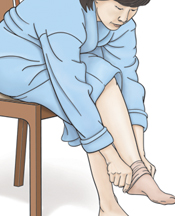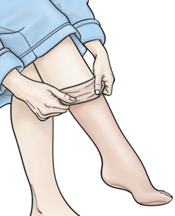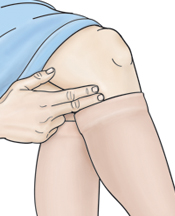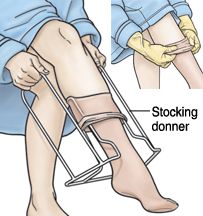Compression stockings are used to treat many vein problems. Wearing them may be the most important thing you do to help your symptoms. The stockings fit tightly around your ankle. They reduce pressure as they go up your legs. This helps keep blood flowing to your heart. As a result, swelling is reduced. Your doctor will prescribe stockings at a safe pressure for you. They will also tell you how often to wear and remove the stockings. Follow these instructions closely. Don't buy or wear these stockings without first seeing your doctor.
Tips for wear and care
To wear stockings safely and to get the most benefit:
-
Wear the length prescribed by your doctor.
-
Pull them to the needed height and no more. Don’t let them bunch at the top. This can restrict blood flow. And that can increase swelling.
-
Wear the stockings for the amount of time advised. Replace them when they start to feel loose. This will likely be every 3 to 6 months.
-
Remove them as your doctor directs. Wash your legs. Then check your legs and feet for sores. Contact your doctor if you find a sore. Don’t put the stockings back on unless you're told to.
-
Wash the stockings as instructed. They may need to be hand-washed.
People who can't put on support hose or socks may be able to use other devices, such as:
-
Intermittent pneumatic compression (IPC) devices: These sleeves inflate. They're worn on the lower legs to help blood flow and to prevent blood clots. A plastic sleeve is placed over each foot and around the calf. The sleeve is plugged into a small machine that inflates it.
-
Sequential compression devices (SCDs): These sleeves are attached to a pump that inflates and deflates them. The pumping action helps blood flow and prevents clots.
-
Compression wraps: These fabric wraps are secured with Velcro.
-
Elastic bandages and Velcro wraps: These can be easier to put on than socks. They can help people who have trouble putting on socks.
-
Inflatable garments: These cover the legs and inflate to provide pressure. They are often used by athletes.





